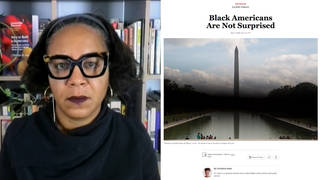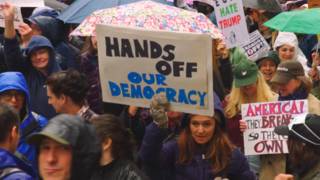
Topics
Guests
- Kate Clifford Larsonauthor of Bound for the Promised Land: Harriet Tubman, Portrait of an American Hero.
Web-only interview with historian Kate Clifford Larson about her biography of Harriet Tubman and the Trump administration’s scuttling of plans to replace President Andrew Jackson’s portrait on the $20 bill with Tubman by 2020—the 100th anniversary of women being granted the right to vote.
Transcript
AMY GOODMAN: This is Democracy Now!, democracynow.org, The War and Peace Report. I’m Amy Goodman, with Nermeen Shaikh.
NERMEEN SHAIKH: The Trump administration is under fire for delaying plans to replace Andrew Jackson’s portrait on the $20 bill with abolitionist leader Harriet Tubman. Treasury Secretary Mnuchin made the announcement last week, saying Tubman won’t appear on the bill until at least 2026. Under a 2016 Obama initiative, Tubman was originally scheduled to replace Andrew Jackson by 2020—the hundredth anniversary of women being granted the right to vote. She’ll be the first woman in over a century and the first African American to appear on the front of a U.S. banknote.
AMY GOODMAN: President Trump cited President Andrew Jackson as his favorite president. This is Trump speaking on NBC in 2016.
DONALD TRUMP: I think Harriet Tubman is fantastic. I would love to—I would love to leave Andrew Jackson and see if we can maybe come up with another denomination. Maybe we do the $2 bill, or we do another bill. I don’t like seeing it, yes. I think it’s pure political correctness. Been on the bill for many, many years, and, you know, really represented somebody that really was very important to this country. I would love to see another denomination, and that could take place, I think. I think it would be more appropriate.
AMY GOODMAN: Andrew Jackson was a slaveholder who, in 1830, signed the Indian Removal Act, which forced 16,000 Native Americans from their lands in what became known as the Trail of Tears.
Well, for more, we continue our discussion, Part 2 of our conversation, with Kate Clifford Larson, the author of Bound for the Promised Land: Harriet Tubman, Portrait of an American Hero. She’s a consultant for the Harriet Tubman special resource study of the National Park Service.
In Part 1, you described who Harriet Tubman was. Now I want to ask you about President Trump’s suggestion. Why not put her on a $2 bill? Kate Clifford Larson, when was the last time you saw a $2 bill?
KATE CLIFFORD LARSON: I would say maybe 20 years ago, probably longer than that. And I think it’s incredibly insulting that he suggests that Harriet Tubman be put on a $2 bill. I think it just shows his disregard for a true American patriot, a veteran, a woman who fought for civil rights and freedom, and, you know, just decided that Andrew Jackson was his man and he belonged on the $20 bill. He’s wrong. He is very wrong. And Andrew Jackson no longer represents values that Americans say that they celebrate and fight for.
AMY GOODMAN: So, you—in 2017, you visited the Bureau of Engraving to see what this banknote, what this $20 bill, would look like. Can you describe the process, first of all, where Harriet Tubman was chosen to replace Andrew Jackson? Just tell us that whole history.
KATE CLIFFORD LARSON: It began earlier in the 2010s. A young girl had sent a letter to President Obama and asked him why there wasn’t a woman on our currency. And, of course, a lot of people had been wondering that, but this young girl just encapsulated that concern. And he rose to the occasion and said, “Well, we’re looking into it.” And Secretary Lew made the final decision that the $5, $10 and $20 bill would all be redesigned to incorporate women.
In the meantime, a group of activist women started a campaign, Women on the 20, and people around the country, hundreds of thousands, if not over a million people, voted and overwhelmingly decided that Harriet Tubman belonged on the $20 bill. And so, Secretary Lew made that announcement in April of 2016. We were all thrilled. And the other banknotes were going to have women incorporated onto the backs of those notes.
And so, in 2017, I was invited with a group of other people to go to the Bureau of Engraving and meet the artists and designers that were creating the new note. And it was an incredible, incredible experience to see what they had done.
AMY GOODMAN: Can you talk about Harriet Tubman and how she ultimately freed herself and then freed so many other people?
KATE CLIFFORD LARSON: Harriet Tubman was about 27 years old in 1849, and her enslaver had died and left his family deeply in debt. And in order to pay those debts, they were going to sell Tubman and her family. So she decided she would take her chances by running away and taking her own liberty, which she did do with the help of black and white Underground Railroad operators, and she made her way to Philadelphia.
But when she arrived there, she was nominally free, but freedom was not very—what she expected it to be, because everyone she loved was back in Maryland, and they were enslaved. So she determined then she would go back and rescue them. And for over 10 years, she returned 13 times to bring away all of her family members and people that she loved.
And so, then, when the Civil War started, her mission was to make sure that all people were liberated. And she brought her battle against slavery to the South with the United States Army and became a spy and a scout. And she was a remarkably successful scout and greatly admired by Civil War Union generals and officers and soldiers alike.
NERMEEN SHAIKH: Well, Kate, can you talk about the raid at Combahee Ferry that Harriet Tubman guided, freeing some 700 enslaved people? The famous black feminist organization the Combahee River Collective named itself after this raid.
KATE CLIFFORD LARSON: That’s right.
NERMEEN SHAIKH: Last year, Democracy Now! spoke with Keeanga-Yamahtta Taylor, assistant professor of African American studies at Princeton University. She’s the editor of a new collection of essays titled, quote, How We Get Free: Black Feminism and the Combahee River Collective. This is Keeanga.
KEEANGA-YAMAHTTA TAYLOR: The Combahee Collective named themselves after a raid that was led and conducted by Harriet Tubman in 1853 in South Carolina, along the Combahee River, that freed several hundred slaves. And that really was—they wanted to name themselves after a political act, which I think is very important to their politics, which is identifying clearly the ways that black women are oppressed.
And I think that that is a important contribution that the Combahee River Collective makes, the discussion about interlocking oppressions, how the way that black women experience oppression in our society cannot just be factored through the lens of race, it cannot just be factored through the lens of sexism or gender oppression, but we look at how those factors together create even new ways of understanding oppression. And so, they talked about interlocking oppressions.
NERMEEN SHAIKH: So, that’s Keeanga-Yamahtta Taylor, assistant professor of African American studies at Princeton University. She’s written a book on the Combahee Collective. Can you talk about what she said, respond to what she said, and also the fact that some have criticized the idea that Harriet Tubman should represent U.S. currency at all? In a 2015 essay, writer Feminista Jones wrote, quote, “If having Harriet Tubman’s face on the $20 bill was going to improve women’s access to said bill, I’d be all for it. But instead, it only promises to distort Tubman’s legacy … [which] is rooted in resisting the foundation of American capitalism.” So, that’s Feminista Jones. So, could you respond to both these comments, Kate?
KATE CLIFFORD LARSON: So, the first, the professor’s comments about Tubman and the oppression that she experienced was very real. And the incredible thing about Tubman is that she was brilliant. She was a genius. Even though she could not read or write, she was a brilliant strategist. There was some level of courage and lack of fear that she had that just pushed her forward. She had entrée into any Union officer’s ear. She could meet with any of them. She was welcome. They listened to her. They admired her. That was a remarkable moment in time during the Civil War. She even was able to testify in a military trial against a white soldier. And, of course, after the Civil War, the rights of African Americans were greatly diminished. But she lived in this moment of time where she experienced tremendous respect because of who she was, this incredibly capable black woman.
So, it’s just—it’s thrilling to hear them talk about naming the organization after the raid that she conducted. Harriet Tubman had eight male scouts working for her. And it was through their work and her work that she went to the Union Army and said, “We can do this plan”—sail up the Combahee River and blow up bridges and liberate people and get rid of, you know, some of the rebel outposts that were posing problems for the Union Army trying to get into the interior in South Carolina. So, she was an amazing soldier and brilliant.
And the second comment about not wanting Tubman on the $20 bill is quite remarkable to me. And the explanation for not wanting her on the $20 bill is because this particular person felt that Tubman fought against American capitalism. And, in fact, while Tubman fought against enslavement and slavery, she herself was an entrepreneur. She was a businesswoman. And I think that she would be immensely pleased to be on the $20 bill. And I think of men and women and children around this country—around the world, actually, because the $20 bill is the most used currency around the world—to have them look at this image of a freedom fighter, a woman of color, a woman of courage, of brilliance and genius, who came from nowhere, who came from the most obscure and oppressed circumstances, to rise above, take her freedom and her liberty, bring it to other people and continue to persist and persevere—so, I just don’t understand that feeling that she doesn’t belong on the $20 bill, when she herself was an entrepreneur and a businesswoman and wanted people to have self-determination, to be able to make a way in the world. And I think having her on the $20 bill would go a long way to inspiring people to do that.
AMY GOODMAN: Kate, talk about how you came to write the biography of Harriet Tubman. Talk about your own history.
KATE CLIFFORD LARSON: Back in 1993, I was working for a small, regional investment bank, and I had my MBA. And I decided that that just was not inspiring me anymore. And I had always had a passion for history. And I decided to go back and get my master’s in women’s history.
At the same time, my daughter was 7 years old and in second grade, and she came home with a little biography of Harriet Tubman. And while I was vaguely aware of Tubman at the time, reading the little children’s book inspired me to look for an adult biography. And the last one that had been published at that time was in the 1940s. And I was stunned. And so were my professors at Simmons. And that set me on a journey to continue my studies and get my Ph.D., and my dissertation was the biography of Harriet Tubman.
And it turned out that there was so much information to be had about her, because she met so many different abolitionists who were overwhelmed by her personality, her presence, her courage, the things that she had done, and they wrote about her. And every single day, she inspired me to keep moving forward with that biography.
And ever since then, I’ve continued to research her life, since my book came out in the early 2000s. And I’ve consulted for the National Park Service. We now have two parks dedicated to Harriet Tubman, one in Maryland and one in Auburn, New York, where she spent the last 50 years in freedom. And there are so many things happening about Tubman now, and I feel so fortunate and grateful to be part of bringing her story to the public.
AMY GOODMAN: Can you talk about the comparison of Harriet Tubman’s life, her enslavement, how she became free, fought to ensure others were freed, and the life of Frederick Douglass, the abolitionist?
KATE CLIFFORD LARSON: Well, it’s an interesting comparison. Frederick Douglass was born on the Eastern Shore of Maryland, as well, in 1818, about four years before Tubman was born. He was enslaved like Tubman. He was mistreated like she was. And he had advantages of being able to—spending time in Baltimore. He learned to read and write. And then he took his freedom with the help of his free-born wife, who was also born on the Eastern Shore of Maryland.
Frederick Douglass was an orator and a statesman. He did not do the work that Tubman did going back into basically enemy territory and fighting the battle of slavery on the ground there by rescuing people and bringing them north, frustrating those slaveholders by robbing them, basically, of their property. But Frederick Douglass was on the stage, and Harriet Tubman was, under the cover of nighttime, going back and rescuing people. And, in fact, one time Frederick Douglass wrote about Tubman. He said that while his work was in the limelight, hers was under the midnight stars.
NERMEEN SHAIKH: Well, Kate, can you talk about what most surprised you as you were writing this biography? And what are the biggest misperceptions about Harriet Tubman?
KATE CLIFFORD LARSON: Well, first of all, I was surprised at her humor. She had great humor. And people who met her wrote about that. It was a very dry sense of humor. And she also was brilliant. She remembered everything that she heard and saw. She could recite passages from the Bible. She was really a genius. And, unfortunately, genius back in those days was recognized only through letters, people who could write and read letters. But she had this amazing skill to be able to read a landscape, to read the night sky, to read people, to hear and listen and sense danger.
She was also an incredibly spiritual person. She deep and profound faith in God. And she believed that God protected her on all of these missions. And I don’t know if anyone can argue with her about that, because certainly she risked her life every single day, and she was never caught, and she was incredibly successful.
So, those are just some of the things that surprised me. She just—her presence sparked awe in people. She was only five feet tall, but people who met her were overwhelmed by her personality. John Brown, the famous John Brown who struck really the first blow of the Civil War on his attack at Harpers Ferry, when he met Harriet Tubman, he was overwhelmed by her, and he called her General Tubman, which is remarkable at that time period for a white man to call a small, petite black woman a general. So, that just gave me a sense of the strength of her personality and her character.
And she was an incredible leader because people followed her, and sometimes they weren’t even sure why, particularly on the Underground Railroad. But she inspired confidence, and her leadership style was profound and very successful.
AMY GOODMAN: And, Kate Clifford Larson, did Harriet Tubman know Sojourner Truth?
KATE CLIFFORD LARSON: They did not really know each other. They met each other once. And Tubman mentioned that she regretted—Sojourner Truth had told her that she had met Abraham Lincoln. And Tubman had not met Lincoln. And apparently she had an opportunity, and she did not. And she regretted that, because she determined that he ultimately was a very good man who helped end the Civil War and liberate enslaved people.
AMY GOODMAN: Finally, artist Dano Wall has created a stamp that can be used to superimpose Harriet Tubman’s image over President Andrew Jackson’s on the $20 bill. This is Wall speaking to MSNBC, explaining why he decided to make the stamp.
DANO WALL: This country has a long issue with representation and equity. In general, I think we live in a racist society. And currency, by virtue of its ubiquity, has the power to spread ideas about who we are as a nation and what we represent. And so, I felt it was a really monumentally symbolic, important change to include Harriet Tubman on the $20 bill, and was really enraged and heartbroken when it sounded like that was going to be taken away.
AMY GOODMAN: So, that was artist Dano Wall. You, too, have a stamp, is that right, Kate?
KATE CLIFFORD LARSON: I do. I had it made about a year and a half ago, just an online company that makes stamps. And I sent them a little head shot of Tubman, and they made the stamp. And I stamp my $20 bills.
AMY GOODMAN: So, maybe it’s going to happen by the centennial of women getting the right to vote anyway, people just stamping these bills.
KATE CLIFFORD LARSON: Let’s hope. Let’s hope.
AMY GOODMAN: Well, Kate Clifford Larson, we thank you so much for being with us, historian and Harriet Tubman scholar, author of_Bound for the Promised Land: Harriet Tubman, Portrait of an American Hero_.
We will link to our first part of our conversation at democracynow.org. I’m Amy Goodman, with Nermeen Shaikh. Thanks so much for joining us.











Media Options